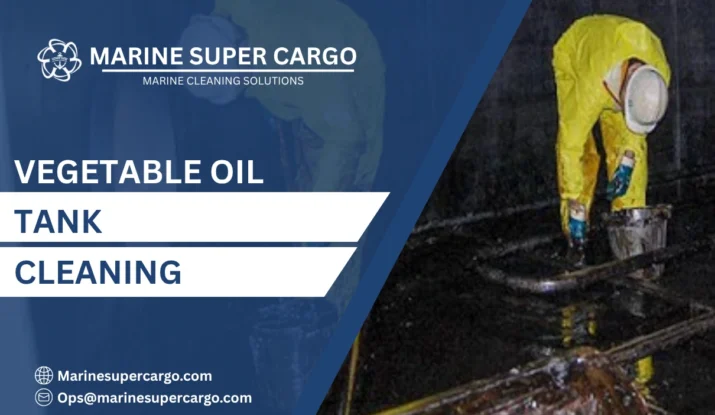Vegetable oil tank cleaning requires meticulous attention to detail and strict adherence to maritime regulations. Whether you’re handling palm oil, soybean oil, or sunflower oil cargo, proper tank cleaning ensures cargo quality, prevents contamination, and maintains vessel integrity. Marine Super Cargo specializes in delivering exceptional services that meet international standards.
Understanding Vegetable Oil Tank Cleaning Challenges
Vegetable oil tank cleaning presents unique challenges for maritime operations. These cargo residues create stubborn films that adhere to bulkheads, deck heads, and tank bottoms. The viscosity of operations demands specialized techniques and heating systems. Unlike petroleum products, vegetable oils solidify at lower temperatures, complicating the cleaning process significantly.
Marine vessels transporting edible oils must maintain pristine conditions throughout each voyage. Vegetable oil tank cleaning ensures the next cargo remains uncontaminated and meets food-grade standards. Marine Super Cargo understands these critical requirements and implements proven protocols.
Pre-Cleaning Preparations for Vegetable Oil Cargo Tanks
Before commencing vegetable oil tank cleaning operations, crews must complete essential preparations. First, ensure all cargo lines running fore and aft are completely drained. Check port and starboard manifolds for residual vegetable oil. Verify heating coils maintain optimal temperatures between 60-70°C for effective.
The MARPOL Annex II regulations govern vegetable oil discharge procedures. Crews must document all vegetable oil tank cleaning activities in the Cargo Record Book. Proper ventilation systems must be operational before personnel enter confined spaces for inspection.

Step-by-Step Process
Step 1: Hot Water Pre-Wash
Begin vegetable oil tank cleaning by circulating hot water at 70-80°C through tank cleaning machines. Position machines strategically to cover all tank surfaces—forward, aft, port, and starboard sections. This initial phase loosens solidified residues from tank surfaces.
Step 2: Chemical Application
Apply approved tank cleaning chemicals specifically formulated for vegetable oil tank cleaning. These degreasers break down oil films effectively. Ensure chemicals comply with IMO MEPC guidelines for marine pollutants. Allow sufficient contact time—typically 2-3 hours—for optimal.
Step 3: High-Pressure Hot Water Wash
Execute high-pressure washing using heated seawater or freshwater. Vegetable oil tank cleaning efficiency increases with water temperatures above 75°C. Direct spray patterns toward tank corners, frames, and structural members where residues accumulate. Marine Super Cargo technicians ensure complete coverage during this critical stage.
Step 4: Manual Cleaning and Inspection
After mechanical vegetable oil tank cleaning, conduct thorough manual inspections. Crews wearing appropriate PPE must check bulkheads, stiffeners, and hard-to-reach areas. Remove any remaining vegetable oil deposits using approved hand tools. This hands-on step guarantees quality results.
Step 5: Final Rinse and Drying
Complete with a final freshwater rinse. Adequate ventilation accelerates drying processes. Verify tank surfaces are completely dry before surveyor inspection. Proper drying prevents corrosion and prepares tanks for subsequent cargo operations.
MARPOL and IMO Compliance Standards
operations must align with MARPOL Annex II requirements. These regulations specify discharge criteria for noxious liquid substances. The IMO categorizes vegetable oils based on their environmental impact, affecting disposal procedures during.
Ships must carry proper documentation proving compliant methods. Surveyors verify cleanliness standards before issuing tank inspection certificates. Marine Super Cargo maintains comprehensive records ensuring regulatory compliance throughout operations.
Best Practices for Efficient Vegetable Oil Tank Cleaning
Experienced maritime professionals recommend maintaining heating systems throughout cycles. Temperature drops cause re-solidification, extending cleaning duration significantly. Optimize chemical concentrations based on oil type—palm oil requires different solutions than soybean oil for effective.
Planning sequential operations minimizes vessel downtime during. Coordinate with port authorities regarding slop disposal requirements. For more insights, read our guide on chemical tank cleaning best practices.
Safety remains paramount during. Implement confined space entry procedures, maintain continuous atmospheric monitoring, and ensure rescue equipment readiness. Marine Super Cargo prioritizes crew safety throughout every project.
FAQs About Vegetable Oil Tank Cleaning
Q1: How long does vegetable oil tank cleaning typically take?
Standard requires 24-48 hours depending on tank size, residue quantity, and heating efficiency.
Q2: What temperature is ideal for vegetable oil tank cleaning?
Maintain water temperatures between 70-80°C for optimal vegetable oil dissolution during tank cleaning operations.
Q3: Are vegetable oils considered hazardous under MARPOL?
Most vegetable oils are Category Y substances under MARPOL Annex II, requiring specific discharge and cleaning procedures.
Q4: Can seawater be used for vegetable oil tank cleaning?
Yes, heated seawater effectively removes vegetable oil residues, though freshwater final rinses prevent salt deposits.
Q5: What chemicals are approved for vegetable oil tank cleaning?
Use biodegradable, IMO-approved degreasers specifically formulated for food-grade vegetable oil removal.


